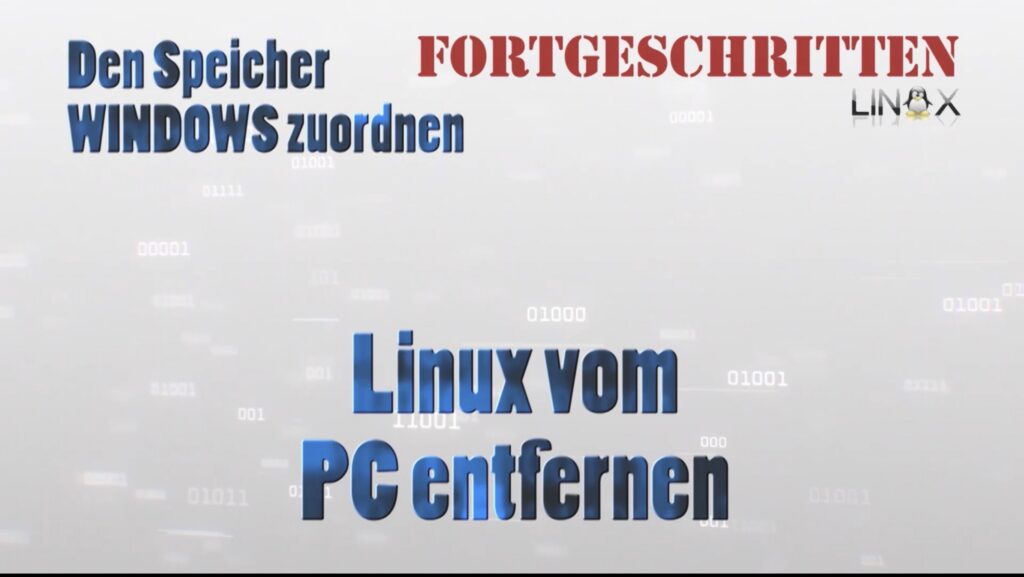Remove Linux from PC and assign memory to WINDOWS
There are users who want to remove Linux from PC and assign memory to WINDOWS. If that’s what you want, here’s how to do it!
1) Important Note — Backup & Recovery
Before deleting anything, make sure to back up the current BCD configuration and create a Windows recovery medium (if possible).
Create a folder for the backup, e.g.:
md C:\BCDBackup
bcdedit /export C:\BCDBackup\BCD.bak
This creates a copy of your Boot Configuration Data (BCD), which you can later restore withbcdedit /import or other tools if needed.
Video: Remove Linux from PC and assign memory to WINDOWS
Language: 🇩🇪|🇬🇧
☝️ Use YouTube subtitles for all languages.
2) Open Command Prompt as Administrator
- Open the Windows Start menu
- Type
cmd - Right-click Command Prompt → select Run as administrator
3) Display All Boot Entries
List all boot entries to find the one referring to LINUX:
bcdedit /enum all
For more detailed output:
bcdedit /v
Look for a section where description or device/path mentions LINUX.
Example:
Windows Boot Loader
-------------------
identifier {current}
device partition=C:
path \Windows\system32\winload.exe
description Windows 10
Real-mode Boot Sector
---------------------
identifier {some-guid}
device partition=\Device\HarddiskVolumeX
description LINUX
⚠️ Important: Write down the identifier (e.g. {9f0c...-...}) of the Linux entry — you’ll need it for deletion.
4) Double-Check Before Deleting
Make sure that:
- The description really says LINUX
- The identifier is correct
Never delete {bootmgr} or {current} — these are required for Windows to start!
5) Delete the LINUX Entry
Once you’re sure, delete the Linux boot entry with:
bcdedit /delete {IDENTIFIER}
Example:
bcdedit /delete {9f0c1234-...-abcd}
To force deletion without confirmation:
bcdedit /delete {9f0c1234-...-abcd} /f
6) Verify the Result
Check again to confirm the Linux entry is gone:
bcdedit /enum all
or
bcdedit /v
7) (Optional) Adjust Boot Order or Default Entry
If needed, set a new default boot entry (usually Windows):
- Identify the correct Windows entry (
{current}). - Set it as default:
bcdedit /default {current} - Adjust boot menu timeout (optional):
bcdedit /timeout 5
8) If Something Goes Wrong — Restore the Backup
If your PC fails to boot, try restoring the BCD backup you created:
bcdedit /import C:\BCDBackup\BCD.bak
If booting fails completely, boot from a Windows installation or recovery medium →
Repair your computer → Command Prompt, and try these commands:
bootrec /fixmbr
bootrec /fixboot
bootrec /rebuildbcd
⚠️ Note: On some systems,
bootrec /fixbootmight fail due to permission issues.
In that case, more detailed repair steps may be needed.
9) Special Cases (UEFI / Firmware)
On modern UEFI systems, additional boot entries (like “ubuntu”) may exist in UEFI’s NVRAM.
These entries don’t get deleted by bcdedit.
You can view them with:
bcdedit /enum firmware
To remove such entries, use:
efibootmgrunder Linux, or- the UEFI/BIOS setup directly.
If you’re unsure whether your system uses UEFI or Legacy BIOS, let me know — I can guide you through the exact steps.

Support / Donation Link for the Channel
If my posts have been helpful or supported you in any way, I’d truly appreciate your support 🙏
#RemoveLinux #IncreaseWindowsStorage #DeleteDualBoot #WindowsBootManager #PCMaintenance #SystemCleanup #TechTips #WindowsGuide



